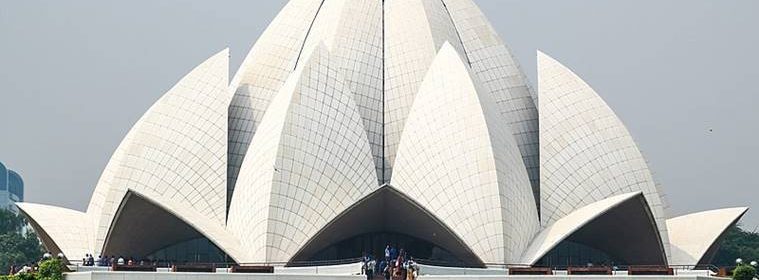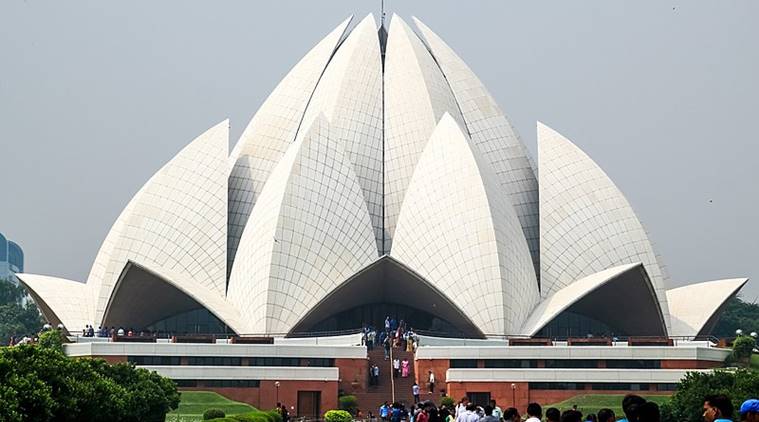Know Your Monument: Lotus Temple and the number nine

In the ninth edition of this series on Indian monuments by Sahapedia, we look at one of the most remarkable monuments in New Delhi – the Lotus Temple. While many know about its lotus-like appearance, there are many other aspects to its grandiose design that make it a fascinating monument.
By Samayita Banerjee
For anyone exploring Delhi’s stunning architecture, there is no want of options of places to explore and admire. However, not many would realise that most of them were actually constructed in pre-Independent India. The Lotus Temple is arguably the only monument on the Delhi skyline that has an interesting architecture and is aesthetically stimulating and has been built post-Independence. The marvellous flower-like structure, located on the western bank of the Yamuna river, is one of the most recognisable landmarks of the Capital. This grand monument, designed by the Iranian architect Fariborz Sahba and completed in 1986, has the most fascinating design out of the 10 Mashriqu’l-Adhkár (Bahá’í Houses of Worship) across the world. No wonder, a 2001 CNN report listed it as one of the most visited buildings in the world.
The Baha’i faith can be traced to mid-19th century Iran. It branched out of the Bábí religion established by Mírzá ‘Alí Muhammad, also known as the Báb. The Bahá’í Houses of Worship are spread all around the world and are located in cities such as Sydney (Australia), Panama City (US), Wilmette (US) and Langenhain (Germany).
Also Read| Know Your Monument: The Ajanta Caves
Going by numbers
While not as ornate, the lotus motif is not unique to India. The central lotus-like architecture of the temple is also found, somewhat vaguely, in the Baha’i temples of Germany, Chile, Cambodia and Colombia. Baha’is regard the lotus as a symbol of purity, beauty and divinity. The temple in Delhi is situated on a podium, and was constructed using concrete, glass, steel and marble. Spread over 26 acres, the complex houses a reception centre, a library, an administrative building and has numerous gardens and pools. Similar to other Baha’i temples, this structure has the signature nine-sided construction, as the number nine is considered special by the Baha’is, who believe that nine is the last single-digit number and symbolises completeness.
The Lotus Temple consists of 27 independent marble petals grouped into clusters of three to form nine sides. The outermost set of nine shells, called the entrance leaves, open outwards and form the nine entrances to the outer annular hall. The next set of nine petals, called the outer leaves, point inwards. The third and final set of petals appears to be partly closed and curve to enclose the central prayer hall, which can accommodate about 2,500 people. Inside the prayer hall, set at the top is the Baha’i’ringstone symbol’, which represents the ‘world of God’, the ‘world of his manifestations’, and the ‘world of humankind’, along with a nine-pointed star, which emphasises the importance of the number nine in the religion.
Syncretised design
Architect Sahba studied the various temples of South Asia to imbibe maximum influence from India’s rich culture. The lotus motif was derived from the Ajanta and Ellora Caves, which depicted the throne of avatars through lotus impressions. Similarly, he drew inspiration from Buddhist architecture, which portrays deep reverence for the lotus motif especially in the depictionof Avalokiteswara (one of the Bodhisattvas, or the previous incarnations of Buddha before he gained enlightenment). He, thus, combined the notion of purity and tenderness of the Baha’i faith with the historical architectural features of Indic aesthetics to construct this modern-day wonder.
Its syncretised design aims at promoting peace, for which it has won numerous awards, including the First Honor award for ‘Excellence in Religious Art and Architecture’ from the Interfaith Forum on Religion, Art and Architecture Affiliate of the American Institute of Architects in 1987, and the GlobArt Academy award in 2000.
In Iran, The Baha’i faith offered newer alternatives to their counterparts, such as ritual purity, respect for all religions, and a rational and modern outlook to their religious practice. This is one of the reasons why the Lotus Temple in Delhi does not discriminate at all on the basis of religion and has been open to all. The significance of the Lotus Temple lies in the spirit of tolerance that the Baha’i faith displays towards practitioners of various religions.
A symbol of tolerance
The Baha’i have had a presence in India since the late 19th century. This unique community has found a new home in India among the spirit of peace and the tolerant ethos of the nation. The growing popularity of this peaceful religion can be observed from the fact that the 2011 Census of India recorded only 4,572 Baha’is, but it has been suggested that the number had surpassed 2 million by 2015.
Today, the Lotus Temple in Delhi serves as the mother temple for all its activities in India and other centres in South Asia, such as Bangladesh, Pakistan, Sri Lanka, Nepal and Bhutan. India is also home to the Baha’i educational institutions located in Maharashtra and Madhya Pradesh through which they organise, promote and maintain their community. Recently, the ruling body declared a second site for a temple in India in Bihar Sharif, which will further promote their ideas of inclusion, peace and harmony.
Trivia:
· The grand structure was designed by an Iranian architect, Fariborz Sahba, and was completed in 1986. He derived the lotus motif from the Ajanta and Ellora Caves.
· The Lotus Temple has nine sides, constructed using 27 independent petals made from marble in clusters of three. Counting the number of petals might be an interesting exercise.
· The Lotus Temple in New Delhi can accommodate about 2,500 people.
· The surface of the temple was built using Pentelikon marble from Greece, which was used in ancient monuments of Parthenon.
· The Lotus Temple has won numerous awards for its architecture, including the GlobArt Academy 2000.
· It is one of the 10 Baha’i Houses of Worship in the world. The others are located in Wilmette, Kampala, Sydney, Langenhain, Panama City, Tiapapata, Santiago, Battambang and Agua Azul.
· The ruling body of the faith has declared that a second temple will be built in Bihar Sharif.
(The article is a part of the extensive coverage of India’s monuments and Saha Sutra by http://www.sahapedia.org, an open online resource on the arts, cultures and heritage of India. Sahapedia offers encyclopedic content on India’s vast and diverse heritage in multimedia format, authored by scholars and curated by experts – to creatively engage with culture and history to reveal connections for a wide public using digital media.)
Source: Read Full Article
